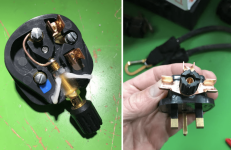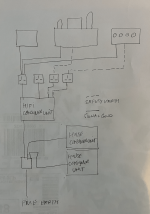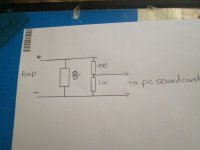Ok, that sounds like a thermal issue and not a leaky cap. If it was a leaky/faulty cap the hum would get worse as time goes on.Last night it had the same response, ZZZzzz when first turned on and then after warmed up with a few songs it disappeared again!
Not sure wether your saying you have a separate HT supply or not. Put that aside for now.
I've advised you a few times to give the amp a good visual inspection, you could also use a stick to fault find. You need a non conductive stick, pen or whatever then gently poke around the amps circuitry to see if the hum changes or goes away. Obviously take care, use your right hand, left hand in pocket etc. You could also try what everyone did in the 1970's with their TV's, give it a thump, the amp that is.
Andy.
I will give the amp a good inspection, I have from the top side, but not thoroughly from the bottom (underside).
As an act of 'refurbishment' I may just swap out the remaining caps and 4 diodes in the regulator as this is about £25 of bits, some of which I already have. The pre-amp is a forever component for me (it has an integral phono stage) and I have compared to modern much higher priced components and prefer this by quite a margin.
I will let you know if I find anything and update the thread.
Whatever is causing this must be changing as it get warm (for the better), but I am not sure why the capacitors still can't be at fault, could diodes alter over time?
It's a noise that does sound like a type of interference, Zzzz but there is nothing obvious that changes to alter this affect in the surroundings
As an act of 'refurbishment' I may just swap out the remaining caps and 4 diodes in the regulator as this is about £25 of bits, some of which I already have. The pre-amp is a forever component for me (it has an integral phono stage) and I have compared to modern much higher priced components and prefer this by quite a margin.
I will let you know if I find anything and update the thread.
Whatever is causing this must be changing as it get warm (for the better), but I am not sure why the capacitors still can't be at fault, could diodes alter over time?
It's a noise that does sound like a type of interference, Zzzz but there is nothing obvious that changes to alter this affect in the surroundings
They could be, but hum caused by faulty PSU caps tends to get worse as the amp warms up.I am not sure why the capacitors still can't be at fault
By your description the zzzz noise might not be 100/120hz. There are loads of signals zipping about in our houses, that's where an oscilloscope is essential in cases like this. It would tell us a lot more about the problem you have: a zzzing noise could be anything and caused by loads of different things.
If it is a high frequency issue grounding the IP usually cures that.
Andy.
Andy,
What about this for a scope to find this sort of noise?
https://www.ebay.co.uk/itm/186393917076?autorefresh=true
What about this for a scope to find this sort of noise?
https://www.ebay.co.uk/itm/186393917076?autorefresh=true
Buying good used scopes can be a nightmare. I can't comment on the Rigol, know nothing about digital scopes. If i were you I'd look for a used 20mhz analogue scope like a Hameg, Old analogue scopes can handle higher voltages better than modern digital ones and are easier to use. This one - https://www.ebay.co.uk/itm/13501303...5i4FhylF6uvDeaksCGTYlUKA==|tkp:Bk9SR4jgxvXeYw is the type of thing I had in mind. Also look for an old Farnell, Scopex, Hitachi, Gould etc but do your research before buying.
1) check that a full service manual is available.
2) do an online search before buying, something like " Zappo 315 scope problem" or "Zappo 315 IC's availability"
3) Don't get a "spares/repair" Check out it's physical appearance, no cracked knobs, dinks & scratches. A bit mucky is ok, but no rust or heavy tarnishing.
4) Find one that is local to you that you can see it working & pick it up yourself. Analogue scopes don't ship well because the CRT's are easily damaged & most people haven't a scooby doo about how to pack one properly.
5) Haggle. Most BIN prices for scopes on Ebay are way too high, that's the Ebay pricing robot thingy.
6) Get a scope that is simple and only uses common transistors or IC's.
7) Don't get an analogue storage scope - too difficult to fix/source scarce parts.
8) Lastly don't get a vintage Tektronix scope, great scopes but a sod to work on/get parts.
Now I know your looking for a scope I'll ask around, you in in the London area? A scope really helps with fault finding and helps you understand electronics better. Andy.
1) check that a full service manual is available.
2) do an online search before buying, something like " Zappo 315 scope problem" or "Zappo 315 IC's availability"
3) Don't get a "spares/repair" Check out it's physical appearance, no cracked knobs, dinks & scratches. A bit mucky is ok, but no rust or heavy tarnishing.
4) Find one that is local to you that you can see it working & pick it up yourself. Analogue scopes don't ship well because the CRT's are easily damaged & most people haven't a scooby doo about how to pack one properly.
5) Haggle. Most BIN prices for scopes on Ebay are way too high, that's the Ebay pricing robot thingy.
6) Get a scope that is simple and only uses common transistors or IC's.
7) Don't get an analogue storage scope - too difficult to fix/source scarce parts.
8) Lastly don't get a vintage Tektronix scope, great scopes but a sod to work on/get parts.
Now I know your looking for a scope I'll ask around, you in in the London area? A scope really helps with fault finding and helps you understand electronics better. Andy.
Could you explain exactly what this includes? It could be interpreted as adding a PE ground loop.My set up is secure from a circuit ground perspective. I have kept the safety ground for the chassis through the power mains plug, and then in my case I have used the chance to separate the circuit ground through a separate plug that is star earthed to the power amp and DAC with low impedance cable.
Also, in general for this kind of troubleshooting, simply turning off sources is not the same as unplugging their interconnecting cables. To rule out a lot of confounders, completely disconnect all sources from the device(s) to be tested. Pull the wires out.
All good fortune,
Chris
Thanks again for all the input. 
I will try and purchase a scope that can monitor the noise in the signal, and do some research on what functions I need to be able to do this. I used to use scopes all the time when I was a university lecturer in engineering, but that was a LONG while ago!!
I have unplugged everything and it made no difference unfortunately, this included anything into the Sp8 and also turning off all power into everything
The strange thing is the variability, last night once again it was present on turning on the system, and after 4 or 5 tracks it was gone again 🤷♂️
Chris, the grounding approach I have which made a useful improvement on sound quality is:
SP8 pre amp Chassis is connected by the mains power plug to safety safety earth as normal, the circuit ground is not connected to chassis earth, connected via the rear panel terminal separately to a low impedance cable to a separate mains plug that ONLY connects to earth
211 Power amp Chassis is connected by the mains power plug to safety safety earth as normal, the circuit ground is not connected to chassis earth, but connected via a connection separately to a low impedance cable to a separate mains plug that ONLY connects to earth
DAC No chassis earth, but I have added a connection separately from Signal Ground to a low impedance cable to a separate mains plug that ONLY connects to earth
All signal grounds are connected in a star pattern to the earth only plug. The DAC connection to add signal GND does add a tiny humm at full volume, but it still sounds better than when it is not connected, and I have 99db/W speakers and a preamp with 23dB gain so I am nowhere near the volume position that creates this hummm (and it's been like this for a couple of years)

I will try and purchase a scope that can monitor the noise in the signal, and do some research on what functions I need to be able to do this. I used to use scopes all the time when I was a university lecturer in engineering, but that was a LONG while ago!!
I have unplugged everything and it made no difference unfortunately, this included anything into the Sp8 and also turning off all power into everything
The strange thing is the variability, last night once again it was present on turning on the system, and after 4 or 5 tracks it was gone again 🤷♂️
Chris, the grounding approach I have which made a useful improvement on sound quality is:
SP8 pre amp Chassis is connected by the mains power plug to safety safety earth as normal, the circuit ground is not connected to chassis earth, connected via the rear panel terminal separately to a low impedance cable to a separate mains plug that ONLY connects to earth
211 Power amp Chassis is connected by the mains power plug to safety safety earth as normal, the circuit ground is not connected to chassis earth, but connected via a connection separately to a low impedance cable to a separate mains plug that ONLY connects to earth
DAC No chassis earth, but I have added a connection separately from Signal Ground to a low impedance cable to a separate mains plug that ONLY connects to earth
All signal grounds are connected in a star pattern to the earth only plug. The DAC connection to add signal GND does add a tiny humm at full volume, but it still sounds better than when it is not connected, and I have 99db/W speakers and a preamp with 23dB gain so I am nowhere near the volume position that creates this hummm (and it's been like this for a couple of years)
Attachments
Yes, but where does the earth only plug go? Does it connect to PE? Don't know where you live or any idea about your local mains wiring.DAC No chassis earth, but I have added a connection separately from Signal Ground to a low impedance cable to a separate mains plug that ONLY connects to earth
All signal grounds are connected in a star pattern to the earth only plug. The DAC connection to add signal GND does add a tiny humm at full volume, but it still sounds better than when it is not connected, and I have 99db/W speakers and a preamp with 23dB gain so I am nowhere near the volume position that creates this hummm (and it's been like this for a couple of years)
If your situation is like North America, where PE is brought back to panel, then connected to both mains neutral and a ****-poor actual Earth rod, then the solution is easy: stop doing that. It would be deliberately adding long ground loops. If not, then maybe you could clarify.
All good fortune,
Chris
Chris,
The layout is like the scketch attached. I hope this makes sense.
The house is supplied by a PME system which has no earth spike, as the incoming earth is very low impedance.
The earth only plug goes back to the same consumer unit, just on it's own earth line back as a separate spur, as each plug is on one spur in the consumer unit, and also 1 MCB.
I don't use balanced, so all connections are single ended.
Rich
The layout is like the scketch attached. I hope this makes sense.
The house is supplied by a PME system which has no earth spike, as the incoming earth is very low impedance.
The earth only plug goes back to the same consumer unit, just on it's own earth line back as a separate spur, as each plug is on one spur in the consumer unit, and also 1 MCB.
I don't use balanced, so all connections are single ended.
Rich
Attachments
You might be able to measure the frequency of the hum with Audacity which has an FFT function or another bit of free software like Soundcard scope. thing is you need a dummy load, IE a 25/50w 8r resistor in parallel with a potential divider to reduce the voltage seen by your PC's soundcard, see sketch attached.
Andy.
Andy.
Attachments
- Home
- Amplifiers
- Tubes / Valves
- Fault detectives, my logic and hypothesis to help with


